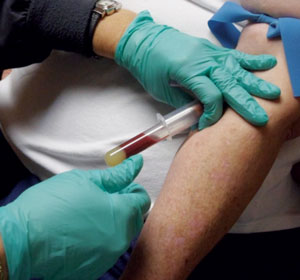 |
Q: I have a patient with severe ocular surface disease with corneal filaments that might benefit from additional echelon measures. However, I’m not sure how to decide between albumin and serum tears. Can you provide indications and preparation protocols?
A: “Experts would agree that because autologous serum (AS) more closely mimics one’s own natural tears—offering not only proteins like albumin, but growth factors, lysozymes and vitamin A, which further support ocular surface health—AS drops would be preferred over albumin drops,” says Richard B. Mangan, OD, of Bennett & Bloom Eye Centers in Kentucky.
Various studies have been conducted on the efficacy of both types of drops, he notes. In one study, albumin drops improved vital dye staining but not tear break-up times or ocular symptoms in Sjögren’s syndrome patients.1 In comparison, patients with Sjögren’s syndrome treated with 20% AS showed improvement in vital dye staining, tear break-up times and symptoms in two to four weeks of treatment.2
 | |
| The patient’s blood is collected to make AS eye drops. |
Paul M. Karpecki, OD, of Koffler Vision Group in Kentucky, agrees, saying that the extra ingredients in AS are the reason he prefers using them. Typically, he adds, the protocol for preparing them involves a laboratory, compounding pharmacist or sometimes a local eye bank.
“The patient’s blood is drawn and centrifuged down so the serum is separated. The serum is then mixed with an artificial tear—typically in a 50% concentration, but it could be lower as well,” Dr. Karpecki explains. “Depending on how much blood is drawn, the patient can obtain anywhere from eight to 15 vials. The one being used is placed in the refrigerator while the others remain in the freezer.”
In some cases, however, 5% albumin drops should be recommended over AS drops, Dr. Mangan says.
“The [production] process from start to finish in supplying preservative-free AS drops to patients is complex,” he explains. “From blood draw and lab testing, to centrifugation, then compounding and ultimately dispensing, the AS process can be somewhat daunting for both patient and prescriber.” Albumin drops, he says, can be shipped directly to a patient’s home from a compounding pharmacy familiar with formulating 5% drops from commercially available stock.
Cost is another factor that could sway a patient. “A 10ml bottle of 5% albumin drops costs roughly $50, while AS can cost two to two and a half times more, not including copays required for the blood draw and any necessary lab work,” Dr. Mangan says. “The upfront costs for a three-month supply of serum tear (standard for a single draw) can be a barrier for some patients.” While true, this is not always the case, says Dr. Karpecki. Some eye banks can make a year’s supply of AS for the price of artificial tears.
Patients who are unable to give blood due to an existing condition that contraindicates it (i.e., poor vein integrity or a vasovagal history), have abnormal labs (i.e., hepatitis, HIV, syphilis) or a history of active infection may also be more suited for albumin eye drop use, Dr. Mangan says.
Regardless, both serum and albumin tears are options to treat the long-term underlying condition, Dr. Karpecki notes. To treat the filaments themselves, he suggests mechanical debridement, topical corticosteroids, compounded acetylcysteine 10%, bandage contact lenses and amniotic membranes such as Prokera.
1. Shimmura S, Ueno R, Matsumoto Y, et al. Albumin as a tear supplement in the treatment of severe dry eye. Br J Ophthalmol. 2003 Oct;87:1279-83.2. Tsubota K, Goto E, Fujita H, et al. Treatment of dry eye by autologous serum application in Sjögren’s syndrome. Br J Ophthalmol. 1999 Apr:83(4):390-5.

